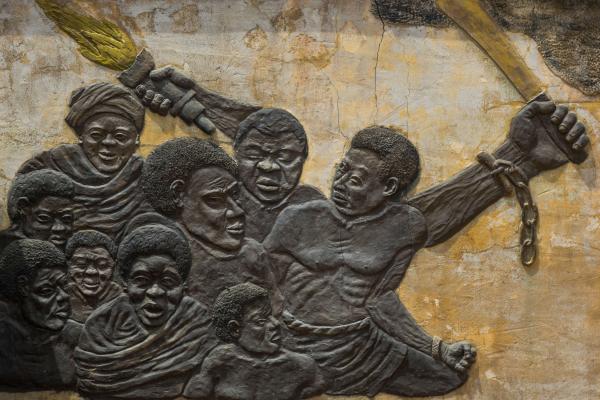In a Cleveland neighborhood, a set of 25 young trees line the space between the sidewalk and the road. The trees were planted by volunteers from Calvary Reformed Church in 2019, an example of the types of actions that churches can take to address rising heat in their neighborhoods. Now, thanks to 2022’s Inflation Reduction Act, nearly $1 billion will fund similar projects across the nation.
In Calvary’s Detroit-Shoreway neighborhood, only about 30 percent of the ground area is sheltered by trees, better than some Cleveland neighborhoods but below the target of 40 percent, a goal the conservationist nonprofit American Forests says is based on climate, geographic region, urban density, and land use patterns.
Historically, redlining policies, which limited where racial minorities could live, led to disinvestment in trees and parks in those neighborhoods. With less trees, the people of color and people with low incomes who reside in these neighborhoods today are experiencing the worst of rising temperatures and heat waves exacerbated by the climate crisis. Establishing adequate tree cover can cool a city block by 10 degrees, according to one study.
Calvary provided the manpower for a local organization and walked from their church after a Sunday morning service to plant trees.
“It was such a joyful day,” said Pastor Dean Van Farowe. “And now we walk down that street and see them getting strong.”
Partnerships like Calvary’s will increase in the coming years. The IRA allotted $1 billion for enhancing green spaces in urban areas, and officials expect churches to be key in putting those funds to use.
“Faith-based organizations are important partners in addressing heat islands because they are pivotal anchors within communities and can assist with tree plantings and other projects that enhance community wellbeing,” Nausheen Iqbal, acting assistant director of the Urban and Community Forestry Program for the U.S. Forest Service, told Sojourners.
Recently, the Church of God in Christ, the largest Pentecostal denomination in the U.S., received $1 million in federal funding to distribute within its network of 13,000 churches. Other churches will benefit from funds given through other partners or states, who also received IRA allocations. The National Religious Partnership for the Environment (NRPE) is working on state-level grant applications and will pass on funds through various creation care ministries.
The program also could generate economic benefits. Bishop Robert G. Rudolph, government affairs liaison for the Church of God in Christ, says the funds will help them generate jobs. And the program offers young Black people exposure to agriculture and related career paths, he told Sojourners.
“Most of our young people, when they think of agriculture careers they think of slavery,” he said. “They don’t know anything about conservation. They don’t think, ‘Hey, I could be a secretary of agriculture,’” referencing Department of Agriculture Under Secretary Homer Wilkes. Rudolph said it was Wilkes who connected COGIC to the funding.
Rudolph pastors two rural churches in Arkansas. Agriculture evokes memories of his grandparents, who told him how Black farmers and families have lost their land due to racist policies at the federal and state levels. He juxtaposes that history with this new program, which must meet the government’s new Justice40 Initiative and ensure 40 percent of the “overall benefits” of federal funding goes to disadvantaged communities.
COGIC plans to include both urban and rural churches in its programming and is working with the USDA, to select the best sites for trees. Rudolph said their planning phase should be close to complete this summer.
The National Religious Partnerships for the Environment anticipates hearing about grant awards between spring and early summer from states who are passing on the IRA funds. So far, they have applications in Tennessee, Florida, Pennsylvania, and North Carolina due to existing relationships with churches there, but Kara Ball, board member from the NRPE, told Sojourners these applications are just “the tip of the iceberg.”
Three Christian environmental groups, A Rocha USA, the Evangelical Environmental Network, and Creation Justice Ministries, see the urban greenspace grants as an opportunity to build new relationships with churches who haven’t taken on such projects in the past.
Avery Davis Lamb, co-executive director at CJM, led an effort to create heat maps in the cities where the three groups already have relationships with churches. The maps will help identify churches which can apply for grants to enhance their greenspaces.
“Too infrequently do [churches] have trees actually planted on their property,” Lamb said. “It’s often just a big lawn.”
The CJM maps visualized data for tree canopy coverage, heat stress, and the areas that Justice40 would consider “disadvantaged.”
While the maps were created for the grant process, Lamb said it’s useful to show faith communities what heat severity in their neighborhood may look like based on their current tree canopy.
Jessica Moerman, president of the EEN, said the $1 billion from the IRA is helpful in “advancing the need for equity, especially for our evangelical churches.”
“In the age of climate change, how can churches look afresh at what it means to serve their community and love their neighbor?” she said.
Rudolph said the same: “It’s alright to preach and teach, but I think we need to minister to the whole man.”
To Rudolph, another benefit of trees is their longevity. Regardless of whichever political party wins control in the next election, the IRA passed, and funds are being awarded.
Van Farowe, who also works as Ohio coordinator for the EEN, pointed out that these projects will do more than just help mitigate rising heat.
“We know that economic value of a neighborhood goes up if there is significant tree canopy,” he said. People also save on heating and cooling bills.
For Cleveland, a Rust Belt city with a lot of manufacturing, trees also improve air quality. Cleveland is the fourth worst city to live in if you have asthma, according to the Asthma and Allergy Foundation of America.
“We know that trees are God’s best filters of the air, so it’s significant for public health that we plant trees,” he said.
Got something to say about what you're reading? We value your feedback!








